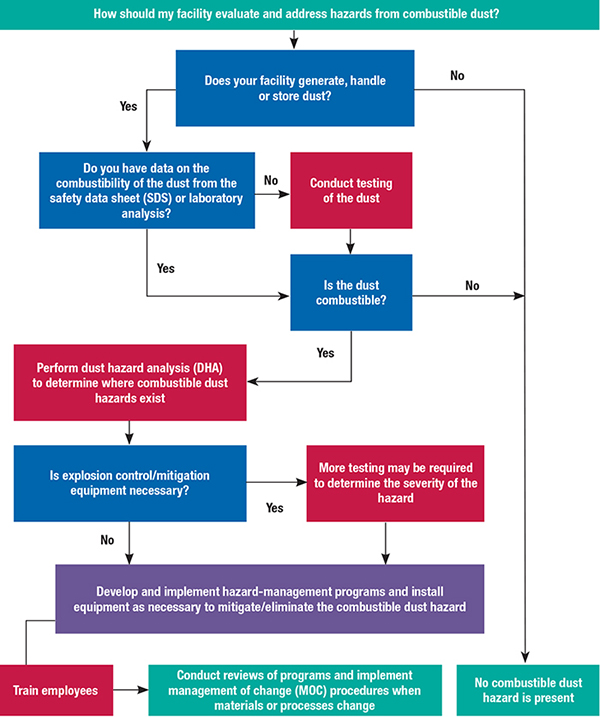The National Fire Protection Association’s (NFPA; Quincy, Mass.; www.nfpa.org) NFPA 652 (Standard on the Fundamentals of Combustible Dust) creates a single, unified combustible-dust standard that applies to “all facilities and operations that manufacture, process, blend, convey, repackage, generate, or handle combustible dusts or combustible particulate solids.” This one-page reference provides information on the NFPA 652 standard and the requirements for conducting a dust-hazard analysis (DHA).
Dust sampling
NFPA 652 includes procedures that all facilities can follow to identify areas where potential combustible-dust hazards exist (Figure 1). An initial step involves collecting dust samples from throughout the facility to determine the combustible or potentially explosive qualities of the dust.
A sampling plan should include the following elements:
• Identification of locations where fine particulate materials and dusts exist
• Collection of representative samples
• Methods to ensure preservation of sample integrity
• Communication with the test laboratory regarding proper sample-handling procedures
• Documentation of samples taken
• Safe sample-collection practices
Following a rigorous sampling plan helps facility operators ensure that the dust samples are accurately analyzed to determine their combustibility.

Figure 1. Evaluation of potentially combustible dusts at a facility involves sampling materials and conducting a dust hazards analysis
Conducting a DHA
For any materials identified as being combustible or potentially explosive, the facility should complete a DHA to evaluate the potential hazards associated with a fire or explosion due to the handling of the materials throughout the facility. Inspections of areas where combustible dust is handled also allow facility operators to develop recommendations to minimize the risks of a combustible-dust incident.
Specifically, a DHA should include the following:
• Identify and evaluate locations or processes throughout the facility where potential fire, flash fire or explosion hazards exist
• Identify and evaluate specific fire and deflagration scenarios where fire and explosion hazards exist
• Identify safe operating ranges
• Identify safeguards in place to mitigate the hazards of a fire or explosion
• Recommend additional safeguards where needed
The DHA must be completed or led by a qualified person who has demonstrated the ability to understand combustible dust and associated hazards through education or experience. This person should inspect all buildings and processes, understand the properties of the potentially combustible dusts present, identify all potential ignition sources, and evaluate the effectiveness of any deflagration-suppression or protection systems that are currently in place.
Taking action
Once a DHA is complete, facilities should work to mitigate combustible dust hazards by both preventing fugitive dust from being discharged from equipment and by installing an effective dust-collection system. The facility should monitor dust hazards and provide training on combustible dusts, including general and job-specific training.
Editor’s note: the material in this column of “Facts at your Fingertips” is adapted from the following article: Frendahl, C., Edwards B. and Davis, J. NFPA 652: Standardizing Combustible Dust Standards, Chem. Eng., May 2016, pp. 74–78.